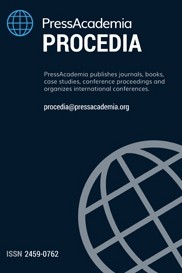CAUSALITY BETWEEN DOW JONES TRANSPORTATION INDEX, CPI TRANSPORTATION INDEX AND TRANSPORTATION SERVICES INDEX
Transportation Services Index, Consumer Price Index, Dow Jones Transportation Index, Causality, United States Grangercausality,
___
- Baker, D., Merkert, R., and Kamruzzaman, M. (2015). Regional aviation and economic growth: cointegration and causality analysis in Australia. Journal of Transport Geography, 43, 140-150. DOI: 10.1016/j.jtrangeo.2015.02.001
- Beyzatlar, M. A., Karacal, M., and Yetkiner, H. (2014) Granger-causality between transportation and GDP: A panel data approach. Transportation Research Part A: Policy and Practice, 63, 43-55. DOI: 10.1016/j.tra.2014.03.001
- Beyzatlar, M. A., and Yetkiner, H. (2017). Convergence in transportation measures across the EU-15. Transportation, 44(5), 927-940. DOI: 10.1007/s11116-016-9686-6
- Chang, Y. H. and Chang, Y. W. (2009). Air cargo expansion and economic growth: Finding the empirical link. Journal of Air Transport Management, 15(5), 264-265. DOI: 10.1016/j.jairtraman.2008.09.016
- Fernandes, E. and Pacheco, R. R. (2010). The Causal Relationship between GDP and Domestic Air Passenger Traffic in Brazil. Transportation Planning and Technology, 33(7), 569-581. DOI: 10.1080/03081060.2010.512217
- Granger, C. W. (1969). Investigating Causal Relations by Econometric Models and Cross-Spectral Methods. Econometrica, 37(3), 424-438.
- Granger, C. W. (1988). Some recent development in a concept of causality. Journal of econometrics, 39(1-2), 199-211.
- Hakim, M. M., and Merkert, R. (2016) The causal relationship between air transport and economic growth: Empirical evidence from South Asia. Journal of Transport Geography, 56, 120-127. DOI: 10.1016/j.jtrangeo.2016.09.006
- Hu, Y., Xiao, J., Deng, Y., Xiao, Y., and Wang, S. (2015) Domestic air passenger traffic and economic growth in China: Evidence from heterogeneous panel models. Journal of Air Transport Management, 42, 95-100. DOI: 10.1016/j.jairtraman.2014.09.003
- Mukkala, K., and Tervo, H. (2013). Air transportation and regional growth: which way does the causality run? Environment and Planning A, 45(6), 1508-1520. DOI: 10.1068/a45298
- Pradhan, R. P., and Bagchi, T. P. (2013) Effect of transportation infrastructure on economic growth in India: the VECM approach. Research in Transportation Economics, 38(1), 139-148. DOI: 10.1016/j.retrec.2012.05.008
- Toda, H. Y., and Yamamoto, T. (1995). Statistical inference in vector autoregressions with possibly integrated processes. Journal of econometrics, 66(1-2), 225-250.
- Yao, V. W. (2005). The causal linkages between freight and economic fluctuations. International Journal of Transport Economics/Rivista internazionale di economia dei trasporti, 143-159.
- Başlangıç: 2015
- Yayıncı: PressAcademia
DENİZLİ İLİ DIŞ TİCARET ANALİZİ
SERMAYE HAREKETLERİ VE KONTROL MEKANİZMALARI
SOSYAL SORUMLU FİNANS: KAVRAMLAR VE YAKLAŞIMLAR ÜZERİNE GÜNCEL BİR LİTERATÜR TARAMASI
Oktay TAS, Alev Varcan BASKAYA, Haluk MERT
İHRACATIN DESTEKLENMESİNDE İHRACAT KREDİ SİGORTASININ ROL VE ÖNEMİ, EKONOMİK BÜYÜMEYE KATKISI
